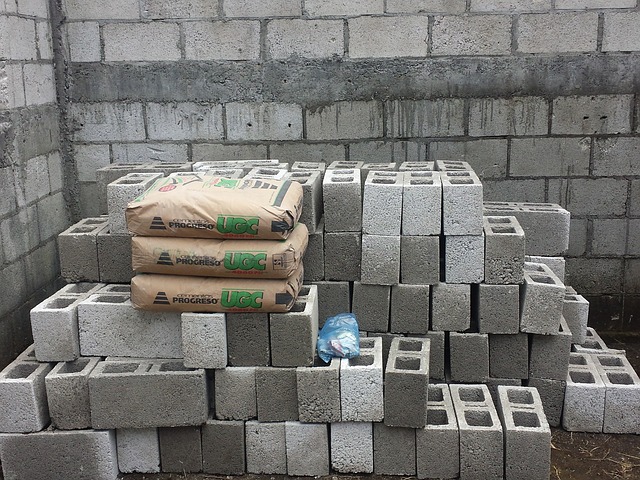Blockwork
Contents |
[edit] Introduction
Blocks are constructed using concrete or cement. They may include a hollow core to make them lighter and to improve their insulation properties. They have been in use since the 1930s when they were commonly used for the inner leaf of cavity walls. At this point they were made from an aggregate of stone or industrial waste such as clinker or breeze, hence the term ‘breeze block’.
They are now used for a wide variety of purposes such as the construction of load-bearing walls, retaining walls, partitions and foundations.
A standard block is 440 mm x 215 mm, the equivalent of 3 bricks high and 2 long, the maximum size that one person can comfortably lift. They are available in a range of widths from 50 mm to 300 mm.
The kind of block selected for a particular application will depend on its:
- Density.
- Load-bearing characteristics.
- Appearance.
- Weight and handling properties.
- Thermal characteristics, such as U-value or thermal mass.
[edit] Dense blocks
Dense blocks are usually made from cement, fine aggregate and coarse aggregate. They can be produced in a range of crushing strengths and tend to be used for structural purposes, such as foundations and load-bearing walls.
They generally have poor thermal insulation and readily absorb water, but have good thermal mass.
[edit] Lightweight blocks
The advantage of lightweight blocks include their thermal insulation characteristics and ease of handling. During the last 80 years a variety of aggregates have been used - clinker blocks (8 parts clinker to 1 part cement), and blast furnace slag. They may be slightly more expensive than dense blocks
[edit] Aerated blocks
Aerated blocks are made from cement, lime, sand, pulverised fuel ash (from power stations). They are popular for a number of reasons, other than their light weight and good thermal insulation:
- Their closed cell structure means they have good resistance to water penetration.
- They provide good fire protection.
- They are easy to cut with a saw.
- They can accommodate fixings such as screws and nails.
Autoclaved aerated concrete (AAC) blocks are manufactured by adding a foaming agent to concrete and then hardening the blocks (autoclaving) with steam.
[edit] Mortar mixes
Mortar mixes should not be too strong. Mixes of cement : sand 1 : 3 are unsuitable because they will not accommodate movement in the blockwork.
For above ground uses, they might include mixes such as:
- cement : lime : sand 1 : 1 : 6
- cement : sand with plasticiser 1 : 6
- masonry cement : sand 1 : 5
- cement : lime : sand 1 : 2 : 9
Below ground a slightly stronger mortar can be used, such as 1 : 0.5 : 4 cement : lime : sand.
Dense blocks are typically laid in mortars of average strength, 1:1:6 or 1:2:9. Stronger mortars may limit movement and may cause cracking of the blocks, although they are sometimes specified below ground level.
[edit] Related articles on Designing Buildings
- Aircrete blocks.
- Ashlar.
- Brick.
- Bricklayer.
- Brick sizes.
- Coal ash.
- Ceramics.
- Concrete.
- Damp-proof course.
- Defects in brickwork.
- Defects in stonework.
- Dust heap.
- Hempcrete.
- How to lay block paving.
- How to lay bricks.
- Lime mortar.
- Mortar.
- Parge coat.
- Pebbledash.
- Perpend.
- Pyrite and mica redress issues in Dail Eireann.
- Quoin.
- Rendering.
- Rustication.
- Screed.
- Stucco.
- Timber.
- Types of brick.
- Types of brick bonding.
Featured articles and news
RTPI leader to become new CIOB Chief Executive Officer
Dr Victoria Hills MRTPI, FICE to take over after Caroline Gumble’s departure.
Social and affordable housing, a long term plan for delivery
The “Delivering a Decade of Renewal for Social and Affordable Housing” strategy sets out future path.
A change to adoptive architecture
Effects of global weather warming on architectural detailing, material choice and human interaction.
The proposed publicly owned and backed subsidiary of Homes England, to facilitate new homes.
How big is the problem and what can we do to mitigate the effects?
Overheating guidance and tools for building designers
A number of cool guides to help with the heat.
The UK's Modern Industrial Strategy: A 10 year plan
Previous consultation criticism, current key elements and general support with some persisting reservations.
Building Safety Regulator reforms
New roles, new staff and a new fast track service pave the way for a single construction regulator.
Architectural Technologist CPDs and Communications
CIAT CPD… and how you can do it!
Cooling centres and cool spaces
Managing extreme heat in cities by directing the public to places for heat stress relief and water sources.
Winter gardens: A brief history and warm variations
Extending the season with glass in different forms and terms.
Restoring Great Yarmouth's Winter Gardens
Transforming one of the least sustainable constructions imaginable.
Construction Skills Mission Board launch sector drive
Newly formed government and industry collaboration set strategy for recruiting an additional 100,000 construction workers a year.
New Architects Code comes into effect in September 2025
ARB Architects Code of Conduct and Practice available with ongoing consultation regarding guidance.
Welsh Skills Body (Medr) launches ambitious plan
The new skills body brings together funding and regulation of tertiary education and research for the devolved nation.
Paul Gandy FCIOB announced as next CIOB President
Former Tilbury Douglas CEO takes helm.
UK Infrastructure: A 10 Year Strategy. In brief with reactions
With the National Infrastructure and Service Transformation Authority (NISTA).























